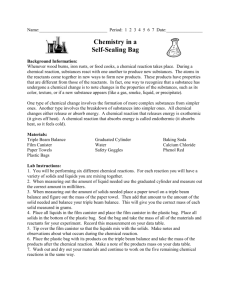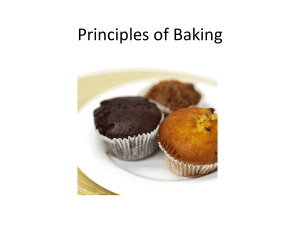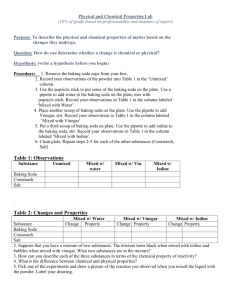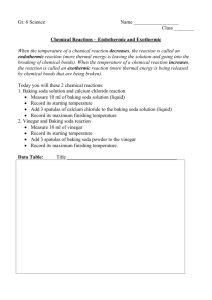Grade 6: Mixtures and Solutions (FOSS) — Investigation 4: Fizz Quiz
advertisement
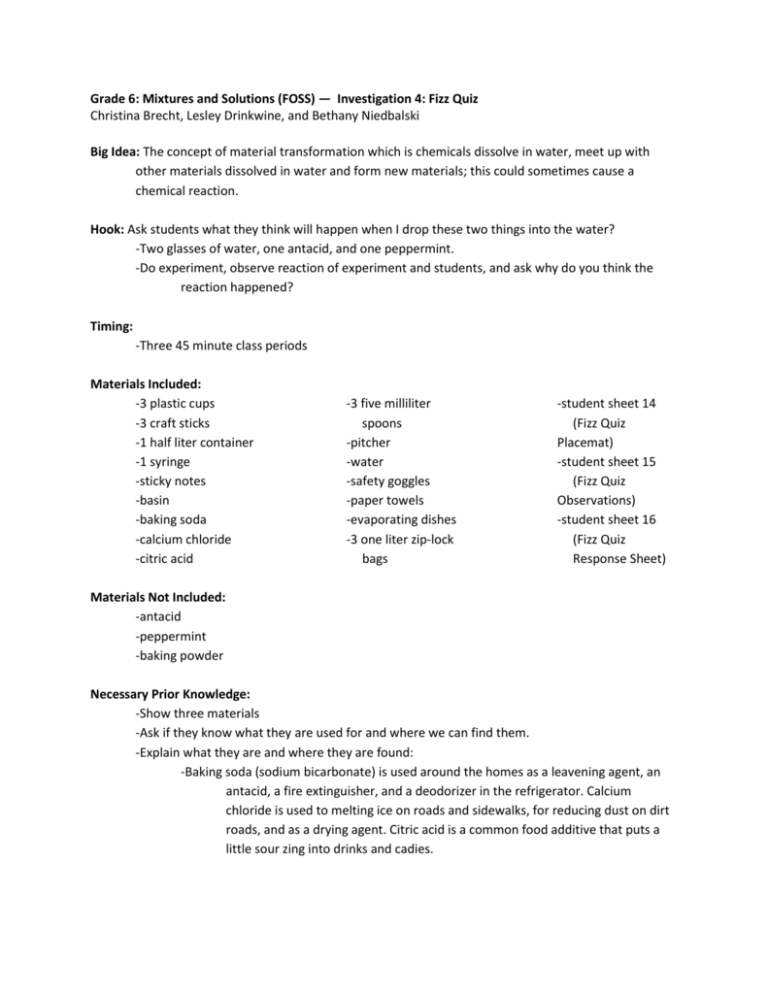
Grade 6: Mixtures and Solutions (FOSS) — Investigation 4: Fizz Quiz Christina Brecht, Lesley Drinkwine, and Bethany Niedbalski Big Idea: The concept of material transformation which is chemicals dissolve in water, meet up with other materials dissolved in water and form new materials; this could sometimes cause a chemical reaction. Hook: Ask students what they think will happen when I drop these two things into the water? -Two glasses of water, one antacid, and one peppermint. -Do experiment, observe reaction of experiment and students, and ask why do you think the reaction happened? Timing: -Three 45 minute class periods Materials Included: -3 plastic cups -3 craft sticks -1 half liter container -1 syringe -sticky notes -basin -baking soda -calcium chloride -citric acid -3 five milliliter spoons -pitcher -water -safety goggles -paper towels -evaporating dishes -3 one liter zip-lock bags -student sheet 14 (Fizz Quiz Placemat) -student sheet 15 (Fizz Quiz Observations) -student sheet 16 (Fizz Quiz Response Sheet) Materials Not Included: -antacid -peppermint -baking powder Necessary Prior Knowledge: -Show three materials -Ask if they know what they are used for and where we can find them. -Explain what they are and where they are found: -Baking soda (sodium bicarbonate) is used around the homes as a leavening agent, an antacid, a fire extinguisher, and a deodorizer in the refrigerator. Calcium chloride is used to melting ice on roads and sidewalks, for reducing dust on dirt roads, and as a drying agent. Citric acid is a common food additive that puts a little sour zing into drinks and cadies. Lesson: -Follow the investigation 4 parts 1, 2, and 3. Suggested Adaptations/Improvements to the Procedure: -Combing parts one, two, and three of investigation 4. Reflection: -Have students write down three things they have learned. -Response sheet: Fizz Quiz page 16 Suggestions for Lesson Extensions/Addenda: -Find out how chalk is made. -Have students compare the crystals from the evaporated baking soda solution, calcium chloride solution, and citric acid solution. -Baking powder is different from baking soda, but both are used in cooking. Have students find out how they are the same and how they are different. The reaction of baking powder in water of different temperature might suggest a difference and might be a clue to the ingredients in baking powder. (Baking powder is a mixture of a dry acid and baking soda, and the reaction is accelerated by heat.) -Math extension: Follow this problem—Rachael was interested in the reactions that produce carbon-dioxide gas. She wondered if there was some way to predict how much gas a reaction would produce. She did the series of seven experiments recorded below and measured the amount of carbon dioxide released by each one. Baking soda 1 spoon 1 spoon 1 spoon 2 spoons 2 spoons 2 spoons 3 spoons Calcium chloride 1 spoon 2 spoons 3 spoons 1 spoon 2 spoon 3 spoons 1 spoon Carbon Dioxide 800 ml 1600 ml 1600 ml 800 ml 1600 ml 2400 ml 800 ml -Based on Rachel’s experimental results, answer the questions: 1. How many milliliters of gas would be produced if 3 spoons of baking soda reacted with 3 spoons of calcium chloride? 2. How many milliliters of gas would be produced if 2 spoons of baking soda reacted with 1.5 spoons of calcium chloride? 3. Rachel wanted to produce exactly 200 ml of carbon dioxide. How much baking soda and calcium chloride should she use?
